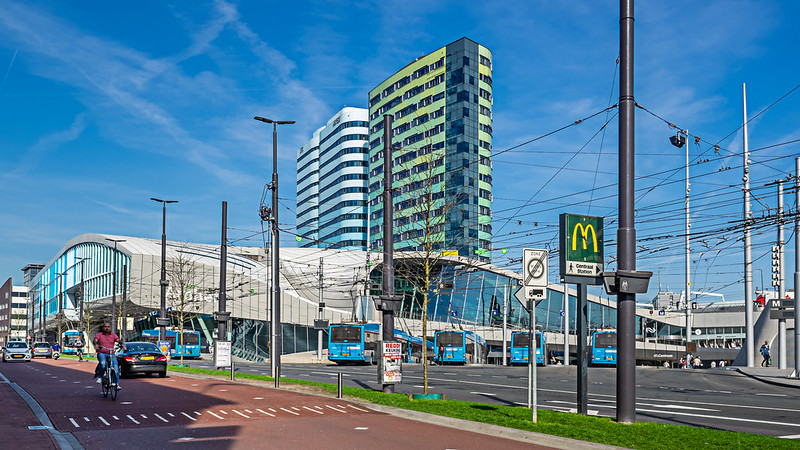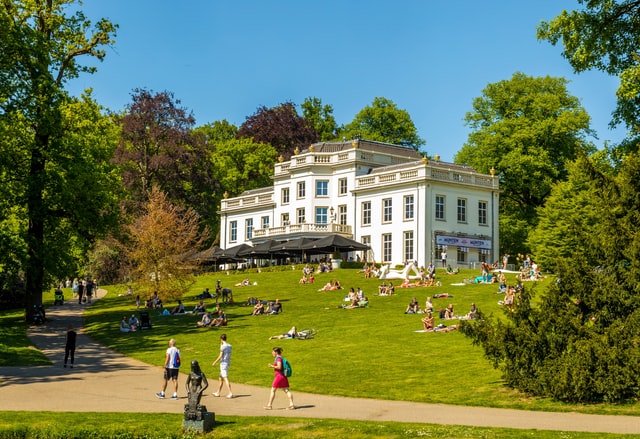This Dutch city is ripping up concrete to prepare for future floods
The Dutch city of Arnhem has released a climate change adaptation plan with a specific goal of replacing grey asphalt paving into greenery.
A
rnhem, a mere 13 meters above sea level, has experienced extreme weather over the last few years. In 2014, flooding was so heavy that parts of the city were submerged underwater. “The rubber boats passing through the streets are still clear in our minds,” said the writers of the report on the city’s climate adaptation strategy.
As well as flooding, heat and drought have been increasing. In 2019, temperatures reached almost 40 degrees Celsius and droughts dried up gardens and parks. The spring of 2020 was the area’s third dry spring in a row. Reports show that Europe is heating up faster than the global average.

The city aims to reduce asphalt cover by 10 per cent. Photo by Frans Berkelaar/Flickr (CC BY-ND 2.0)
“Last summer many people suffered from the extreme temperatures that ravaged our country,” said city alderman Cathelijne Bouwkamp. “The temperatures are rising enormously, especially in places where there is a lot of stone and concrete.”
Asphalt, the material roads are made from, increases water runoff whereas soil, trees, grasses and plants absorb rainfall. Trees also create shade and a cooling effect whereas asphalt absorbs heat and creates warmer temperatures.
The city’s specific goal is to reduce asphalt cover by 10 per cent to prevent 90 per cent of rainwater from running off into the sewer systems. Arnhem has a significant amount of paving, especially in built-up areas, which is not functional and could be put to better use.
“We are going to clean up insertion lanes and road sections, where according to our research very few cars drive,” said Bouwkamp.
These areas will be turned into places for plants and grasses to thrive. Trees will be given more space to grow. In other areas where roads are necessary for accessibility, trees will be planted to increase shade and cooling areas.
“Arnhem is at the forefront when it comes to climate adaptation,” said Bouwkamp. Limiting the risks of climate change, keeping the city livable, improving resilience and protecting inhabitants are the city’s aims.
Being data-smart
Since 2009, researchers have been strategically measuring and studying the climate in the city of Arnhem to find ‘urban heat spots’ and areas vulnerable to the effects of global heating.
Using climate measuring bikes, weather stations on the roofs and infrared imaging from planes, the city has managed to build a picture of which areas are sensitive to extreme heat, flooding and weather events. The evidence, which was built upon with more detailed studies in 2012, showed that tree-lined streets, parks, gardens and areas with water and vegetation were the coolest, and had a cooling effect on the wider area.
By allocating resources into mapping and measuring the climate of the city, Arnhem is in a position to make smart decisions about where to focus its adaptation efforts. The city council will vote on the strategy after the summer.

Researchers have been strategically measuring the climate in the city to find ‘urban heat spots’. Photo by Martijn Baudoin on Unsplash
Additional adaptation benefits
Preserving and increasing the health of the natural environment will have other benefits too: contributing to greater biodiversity and the declining trend of species, as well as improving the mental and physical health of residents.
Earlier in 2020, inner-city locals could register for a free tree and birdhouse for their garden or outside space. It was available for those living in ‘urban heat spots’, areas most threatened by summer heat. A local ‘adopt a bee’ biodiversity foundation has also launched, which encourages residents to plant and garden in a similar way to form habitats and wildlife corridors for endangered pollinators and other species.
Getting the locals involved
Involving citizens as well as various groups in climate adaptation plans is a hallmark of Arnhem’s strategy. After the flooding in 2014, meetings were held with local residents who were asked to contribute ideas to make neighborhoods more resilient to flooding. “As a city, we cannot do this alone; most of the city’s territory is not public space but private property. We will work together with organizations, corporations and schools,” said Bouwkamp.
With that in mind, the city has made a fund of €450,000 available in subsidies for residents and entrepreneurs with ideas about how to make the city more resilient to global heating, extreme flooding or drought over the next three years.
The ideas presented in this article aim to inspire adaptation action – they are the views of the author and do not necessarily reflect those of the Global Center on Adaptation.